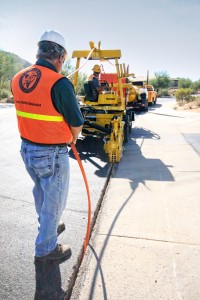January 2011 Vol. 66 No. 1
Features
Vermeer Introduces Microtrencher For Fiber Installation

Vermeer is launching a system for cutting narrow trench in paved rights-of-way, primarily for installing duct for fiber optic cable.
“The target market is the last-mile, fiber-to-the-premises (FTTP) installations,” said Jon Kuyers, product manager of the Vermeer utility segment. “The system is the complete package for installing micro duct for fiber.”
The microtrenching system is available now through the Vermeer dealer organization.
Kuyers said components of the system are:
• Tractor;
• Either of two saw-type microtrenching components;
• Vacuum system; and
• Grout system.
“The basic model for the system is the 65-horsepower, rubber-tire TRX 550,” Kuyers said.
Microtrenching components are designed to cut through asphalt. “Of the two microtrenching attachments, one can cut to 12-inch depths, the other 16 inches deep,” Kuyers said. “That’s because most specs today call for depths of 8, 10, 12 or 16 inches.”
Cutting width can vary from 3/4-inch to 2 1/4 inches with either attachment and is dependent on the cutter wheel and tooth configuration. Each component has offset capability of up to two inches outside the right rear tire. A patent-pending steering guide helps prevent back cutting and enables on-curb seams and other paving edges.
“The method of changing wheels is modeled after the design of circular saws,” said Kuyers. “Using a cordless impact wrench with 5/8-inch socket, a wheel can be changed in about three minutes.”
Cutting options
There are a variety of cutting tool options and configurations to comply with project specifications and road base materials, said Kuyers.
Shark tooth — Available for the 12-inch wheel only, the weld-on teeth make a 3/4-inch-wide cut to recommended depths of 6 inches.
Yellow Jacket cutters — For use on both size wheels, the replaceable teeth fit in welded-on sockets and can be configured for varying trench widths. The Vermeer-exclusive wheel and tooth design provides two cutting edges. Yellow jacket cutters are recommended for asphalt thickness of 6 inches or less.
Rotary bits — Fitting both wheel sizes, these replaceable teeth also fit in pockets on the wheel and are for cutting 1 3/4-inch side trench to depths of eight and 12 inches. There are two types of rotary teeth: one for the 12-inch wheel, the other for the 16-inch wheel.
A cyclonic high-CFM vacuum system is connected to the microtrench attachment via a four-inch hose to simultaneously remove the material as it is cut, leaving a clean trench for placement of duct. The excavated material is not used to refill the trench. Most cities, said Kuyers, require a grout meeting requirements specified by the local governing body or local department of transportation.

During development, Kuyers said Vermeer employed contractor-based testing on fiber projects representative of conditions in which the equipment will be used.
“We experimented with tooth designs and set ups in order to improve performance and durability,” he said. “We believe the result is a productive, cost-efficient microtrenching system for the rapid deployment of fiber optic cable.”
FOR MORE INFO:
Vermeer Corp., (888) 837-6337, www.vermeer.com




Comments